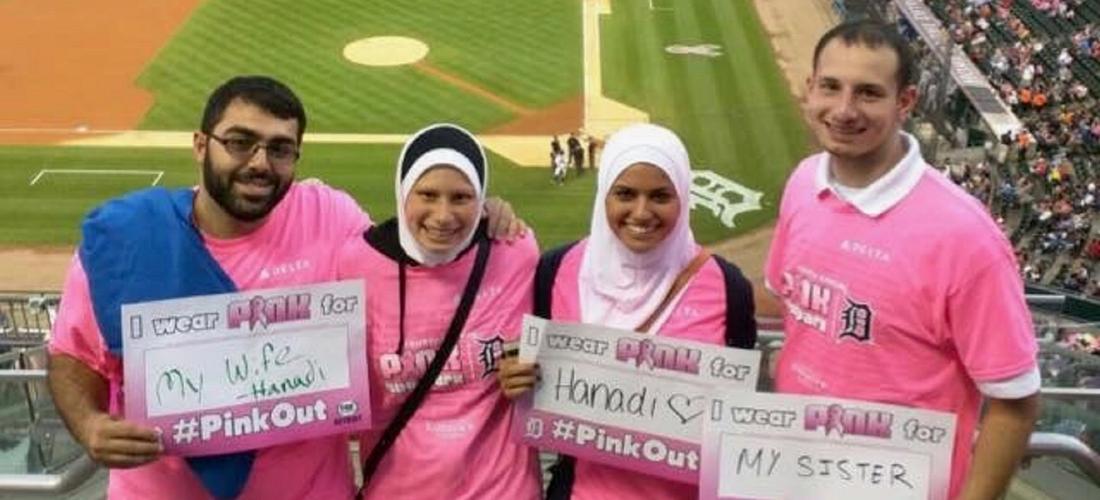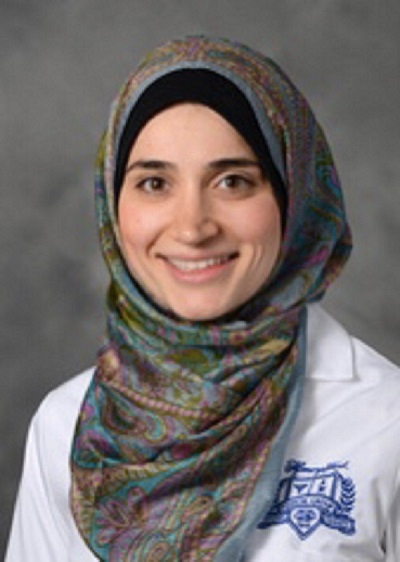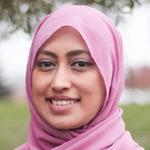Early Detection is Key – Why No One is Immune to Breast Cancer
Community
|
Oct 15, 2020
|
5 MIN READ

Hanadi Badaoui was diagnosed with cancer in 2014. She attended “pink out the park” with her husband Ali, cousin Fathme and brother Ali.
Hanadi Badaoui will never forget June 26, 2014. The day before she was driving home with a friend from visiting her cousin and newborn when she received a phone call. It was her doctor, asking her to come in as soon as possible. She asked her friend to stop by her doctor on the way home.
Her doctor said, “I want you to take your disk [with] your pathology results to Karmanos Cancer Center to confirm it.” Hanadi returned to the car with no emotions. She sat silently in shock. “It wasn’t until I called my fiancé, now my husband, [to tell him] that I have breast cancer that the floodgates opened.”
Her friend who was driving had no idea.
The next day it was confirmed – she had stage 2b invasive ductal carcinoma and one positive lymph node, an aggressive form of breast cancer. “It was so surreal, I was just in shock. I am a very healthy person, I was on the cross country team in high school, I exercised regularly, didn’t eat red meat and was relatively healthy. I have never smoked in my life. So there was nothing to suggest that this was cancer.” At the time she was 24-years-old.
According to cancer.org, “aAbout 80,000 young adults aged 20 to 39 are diagnosed with cancer each year in the United States. About 5 percent of all cancers are diagnosed in people in this age range.”
Hanadi visited her physician to examine the lump she discovered in her breast in May of 2014. The doctor said it was most likely a noncancerous benign cyst, which gave her no inkling to be concerned. But wanting to be sure, Hanadi then got an ultrasound in the beginning of June and a biopsy toward the end of June – testing positive for cancer. She does not have immediate family members with breast cancer.
Now Hanadi wants to raise awareness about early testing if you find a lump or cyst, even if you don’t have other symptoms for breast cancer or family history.
Dr. Hannan Saad, a radiologist with Henry Ford Hospital in Detroit, said there are mixed guidelines on when to get mammograms. While the American College of Radiology recommends at age 40, the U.S. Preventive Studies Task Force says women 50 and up should get annual mammograms. Dr. Saad recommends starting at 40, especially if there is family history.
In the United States, one in every eight women are diagnosed with breast cancer in their lifetime, according to the National Breast Cancer Foundation, Inc., which was created in 1991 to build awareness and resources.
Dr. Hannan said some signs to look for are a lump in one or two breasts, which feels as hard as a rock; an inverted nipple; bloody discharge, or inflamed skin which looks like mastitis. Things can change rapidly, and breast cancer is more treatable if detected early.
Hanadi said her family and friends became instrumental to her survival. “They are the co-survivors in my life,” she says. “I give them credit for being the fighters for me. God strategically placed people [who were] fundamental and intricate to my survival.”
Hanadi was engaged in February of 2014, and by July she had begun chemotherapy. Her now-husband was there for every appointment. She says she didn’t take the five rounds of chemotherapy well. “I wanted to give up so bad … It kind of feels like you got hit by a bus, and then it doesn’t stop.”
Following chemo, she had a lumpectomy to remove the cancerous area followed by radiation. She had a complete response – no cancer remaining. “The absolute greatest response you could ever hear.”
Six years later Hanadi is cancer-free. Breastcancer.org estimates there are 3.5 million breast cancer survivors in the United States, although Hanadi doesn’t prefer the label because she’s afraid that it could come back.

Dr. Hannan Saad is a radiologist at Henry Ford Hospital in Detroit.
Awareness is Key
The World Health Organization says, “Breast cancer is the most common cancer among women worldwide.”
According to the National Breast Cancer Foundation, Inc. risk factors are genetics and environment – often together, although, “60-70 percent of people with breast cancer have no connection to these risk factors at all, and other people with risk factors will never develop cancer.”
Genetic factors are having family members, especially female relatives, who had breast cancer or ovarian cancer. Environmental factors may include poor diet and exercise, getting your period before 12 or starting menopause after 55.
Dr. Hannan said the Arab community falls short when it comes to talking about breast cancer. “It’s taboo to talk about it.” She says many people come in with later stages of cancer due to not getting correctly screened.” Once, she saw a 27-year-old diagnosed with breast cancer who had no family history.”
She said knowing your health history helps you qualify for earlier mammograms. Dr. Hannan says people can get images without a referral by going to a breast imaging center. That can be followed by an ultrasound and biopsy if needed.
Radiologists use the Breast Imaging Reporting and Data System (BIRAD) scale to rank the likelihood of cancer. Hannan says, “A good physician will help expedite biopsy and treatment especially when invasive chemotherapy even before surgery.”
She said the website breastcancer.org is a great resource for information related to diagnoses.
Community Efforts to Testing
Denise L. Hill is a manager and program coordinator for The Breast and Cervical Cancer Control Program (BCCCP), a federally and state-funded program that offers health services for low-income or uninsured women 21-64 years old in Wayne, Oakland, and Macomb counties in Michigan. “Annual breast and cervical cancer screening is very important, but having access to screening is equally important,” says Denise.
The agency has helped 1,577 women in the 2020 fiscal year: 25 percent African American, 11 percent Arab American, 43 percent Hispanic and one percent Asian Americans. The program was created for underserved communities where “cancers were being detected at a later stage,” she says, and provides free services that may include breast and cervical cancer screening, mammograms, Pap smears and pelvic exams.
Services are administered by the Michigan Department of Health and Human Services (MDHHS), and funded by the Centers for Disease Control (CDC) and MDHHS sources. People in the tri-county can call (888) 242-2702 to determine eligibility and set up healthcare options with approved providers. This service is essential for providing testing to those who might not otherwise have it, says Denise.
Similar programs are available in each state thanks to Congress passing the Breast and Cervical Cancer Mortality Prevention Act of 1990 and creating the National Breast and Cervical Cancer Early Detection Program (NBCCEDP), which facilitates women getting tested and receiving treatment on Medicaid.
Hanadi says young people should be vigilant about cancer. “Don’t think you are immune. Cancer does not discriminate.” She says it’s okay to advocate for more testing if you need it.
In hindsight, she says cancer has given her a second chance at life and inspired her to live a more God-centric life. “You don’t suffer that tremendously without a purpose. Because I turn to him: ‘God I am healthier, taking care of my health, I’m leaving the rest in your hands, whatever comes of this… (if I get cancer again God forbid) if anything happens to me it is because it was meant to happen.’”
Subscribe to be the first to know about new product releases, styling ideas and more.
What products are you interested in?

